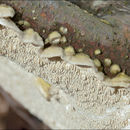en
names in breadcrumbs


Irpex lacteus is a common crust fungus distributed throughout temperate areas of the world. It is the type of the genus Irpex. Irpex lacteus is considered a polypore, but depending on growth conditions it can also produce a hydnoid hymenophore. Due to this variability and abundance of the species it has been described as a new species to science numerous times and subsequently has an extensive synonymy. The complete genome sequence of Irpex lacteus was reported in 2017.[1]
Irpex lacteus is a white-rot fungus that inhabits mainly angiosperm branches and trunks.[2] It is one of the most common wood-rotting fungi for instance in urban North America. It is inedible.[3] The fungus has been identified as a cause of pulmonary infections in immuno-compromised humans.[4]
The fungus was first described in 1818 by Elias Magnus Fries, who called it Sistotrema lacteum.[5] Fries later made it the type species of the genus Irpex in 1828.[6]
Irpex lacteus is a common crust fungus distributed throughout temperate areas of the world. It is the type of the genus Irpex. Irpex lacteus is considered a polypore, but depending on growth conditions it can also produce a hydnoid hymenophore. Due to this variability and abundance of the species it has been described as a new species to science numerous times and subsequently has an extensive synonymy. The complete genome sequence of Irpex lacteus was reported in 2017.
Irpex lacteus is a white-rot fungus that inhabits mainly angiosperm branches and trunks. It is one of the most common wood-rotting fungi for instance in urban North America. It is inedible. The fungus has been identified as a cause of pulmonary infections in immuno-compromised humans.